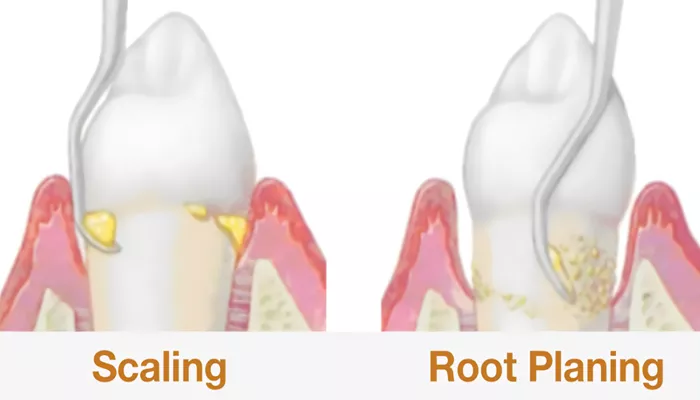Scaling and root planing (SRP) is a common dental procedure used to treat gum disease, also known as periodontal disease. This treatment targets gum inflammation and helps remove plaque and tartar from below the gum line, preventing further damage to the gums and supporting bone. SRP is often recommended for patients showing signs of early to moderate gum disease, especially when simple cleaning is not enough to restore gum health.
What Is Scaling?
Scaling involves cleaning the surface of the teeth both above and below the gum line to remove plaque, tartar (hardened plaque), and bacterial toxins. These deposits contribute to gum inflammation and infection, which can worsen if untreated.
What Is Root Planing?
Root planing is a deeper cleaning process that smooths the roots of the teeth to help gums reattach properly. This reduces pockets that harbor bacteria and promotes healing of inflamed gum tissues. Together, scaling and root planing aim to halt the progression of gum disease and preserve dental health.
Why Is Scaling and Root Planing Necessary?
Gum disease is a common dental problem caused by bacterial infection and inflammation of the gums. It begins as gingivitis, characterized by redness, swelling, and bleeding gums. If untreated, it can progress to periodontitis, where the infection damages the bone and connective tissue supporting teeth.
SRP helps remove the cause of inflammation and infection. Without it, gum disease can lead to tooth mobility, loss, and other health issues.
Does Dental Insurance Cover Scaling and Root Planing?
Whether dental insurance covers scaling and root planing depends largely on the type of insurance plan, the specifics of the coverage, and the diagnosis. Most dental insurance plans recognize SRP as a necessary treatment for gum disease and provide at least partial coverage.
Types of Dental Insurance Plans
Dental insurance plans fall into several categories:
Preventive and Basic Coverage Plans: These often cover routine cleanings and basic procedures. Some may cover scaling and root planing if gum disease is diagnosed.
Comprehensive or Major Coverage Plans: These plans usually provide better coverage for more advanced procedures like SRP.
Dental Discount Plans: These are not insurance but offer discounts on dental procedures including scaling and root planing.
Preauthorization and Diagnosis Requirements
Dental insurance typically requires a formal diagnosis of gum disease to approve SRP coverage. This means a dentist must confirm the presence of gum inflammation or periodontitis through examination and periodontal probing.
Many insurance providers require preauthorization before the procedure to ensure coverage and prevent claim denials.
Coverage Limits and Patient Costs
Insurance plans often cover a percentage of the cost for scaling and root planing—commonly between 50% to 80%. The patient is usually responsible for deductibles, copayments, or any amount exceeding the plan’s annual maximum benefit.
Annual limits for dental insurance can range from $1,000 to $2,000 or more, and SRP costs may count against this limit, so it’s important to verify details with the insurer.
How Gum Disease Relates to Insurance Coverage of SRP
Gum disease diagnosis is central to insurance coverage for scaling and root planing. The procedure is not considered preventive care but rather therapeutic treatment for an existing condition.
Gingivitis vs. Periodontitis
Gingivitis is the earliest stage of gum disease, marked by mild gum inflammation without bone loss. Dental cleanings and good oral hygiene are often sufficient to manage it, and insurance generally covers these preventive cleanings.
Periodontitis is more severe and involves gum inflammation, deep pockets between teeth and gums, and potential bone loss. SRP is a common non-surgical treatment to control periodontitis, and insurance is more likely to cover it when periodontitis is diagnosed.
Periodontal Maintenance and Follow-Up Care
After SRP, periodontal maintenance visits are crucial to prevent recurrence of gum disease. Some insurance plans cover these maintenance cleanings, but coverage levels can vary. It’s important to confirm how often maintenance cleanings are covered.
Factors That Influence Insurance Coverage of Scaling and Root Planing
Plan Type and Network Restrictions
Insurance plans with a preferred provider organization (PPO) network usually cover more for in-network dentists. Health maintenance organizations (HMOs) or dental health maintenance organizations (DHMOs) might have stricter rules about coverage and providers.
Documentation and Clinical Evidence
Insurance companies require proper documentation such as periodontal charting, X-rays, and treatment plans to approve SRP claims. Clear evidence of gum inflammation, pocket depths, and bone loss supports the necessity of SRP.
Frequency Limits
Some plans limit how often scaling and root planing can be performed on the same area, commonly every 2-3 years. Patients should check their policy details to understand these limits.
Alternative or Adjunct Treatments
Insurance might cover adjunct treatments for gum disease like antibiotic therapy or minor surgical procedures, but coverage varies. Scaling and root planing remains the foundational treatment.
What to Do If Insurance Does Not Fully Cover SRP
If your dental insurance does not fully cover scaling and root planing, there are options to consider:
Discuss Payment Plans With Your Dentist
Many dental offices offer payment plans or financing options that allow patients to spread out the cost of treatment over time.
Use Flexible Spending Accounts (FSAs) or Health Savings Accounts (HSAs)
Funds from FSAs or HSAs can be used to pay for dental treatments including SRP, offering tax advantages.
Seek a Second Opinion
If coverage is denied, obtaining a second opinion from another dentist can sometimes support the necessity of treatment or reveal alternative options.
Conclusion
Scaling and root planing is a key procedure in treating gum disease, especially periodontitis. Most dental insurance plans offer at least partial coverage for SRP, but coverage depends on plan type, diagnosis, and documentation.
Patients should carefully review their insurance policy, seek preauthorization, and consult with their dental provider to understand costs and coverage. Proper treatment of gum disease is essential to maintain oral health and prevent tooth loss.

